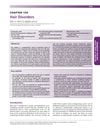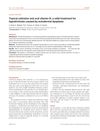TLDR Three Iranian men had reddish-brown facial pigmentation with no effective treatment.
In 1992, three Iranian men aged 15, 18, and 28 presented with increasing pigmentation over their cheeks, extending to the preauricular areas. The pigmentation, which began in childhood, was reddish-brown with a granular texture due to pinhead-sized white follicular papules. Vellus hair growth was affected, but there was no scarring or atrophy. Two patients linked the pigmentation to temperature extremes, and one experienced a burning sensation in sunlight. Despite using sunblocks and topical steroids, there was no improvement. Histopathologic examination of biopsies from two patients showed slight hyperkeratosis, follicular hyperplasia, and intense melanin pigmentation in the basal layer, with mild perivascular mononuclear cell infiltration. The condition was identified as erythromelanosis follicularis faciei et colli.
21 citations
,
August 1991 in “Journal of the American Academy of Dermatology” A rare skin condition was found in a young white girl for the first time.
June 2022 in “Dermatologic Therapy” Oral minoxidil and growth factors improved hair density and thickness in a girl with hereditary hair loss.
 November 2019 in “Harper's Textbook of Pediatric Dermatology”
November 2019 in “Harper's Textbook of Pediatric Dermatology” Understanding normal hair growth and loss in children is key to diagnosing and treating hair disorders.
 5 citations
,
January 2018 in “Acta Dermatovenerologica Alpina Pannonica et Adriatica”
5 citations
,
January 2018 in “Acta Dermatovenerologica Alpina Pannonica et Adriatica” Congenital atrichia with papular lesions causes permanent hair loss in children.
 4 citations
,
August 2016 in “JEADV. Journal of the European Academy of Dermatology and Venereology/Journal of the European Academy of Dermatology and Venereology”
4 citations
,
August 2016 in “JEADV. Journal of the European Academy of Dermatology and Venereology/Journal of the European Academy of Dermatology and Venereology” Using cetirizine on the skin and taking vitamin D can help increase hair growth in children with hair loss from ectodermal dysplasia.
18 citations
,
January 2013 in “Dermatology Online Journal” Trichofolliculoma is a rare skin bump on the face or scalp.
8 citations
,
January 2011 in “International journal of trichology” Accurate diagnosis of APL is crucial to avoid unnecessary treatments.
June 2001 in “European Journal of Dermatology” A 54-year-old woman experienced progressive hair loss starting in adolescence, leading to sparse scalp hair and almost no eyebrows or eyelashes.


